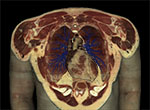Anatomy Relevant to Pulmonary Embolism
by Adam Lawson BA, MSc and Terra Doucette Hiller BA, BSN, RN
Pulmonary Vasculature
If we follow the circulation of blood as it leaves the right ventricle:
- Blood enters the pulmonary trunk
- ...and flows into capillary beds which surround the alveoli of the lungs.
- After gas exchange, oxygenated blood flows through pulmonary veins into the left atrium.

(Click to view animation)
Pulmonary Embolism
A pulmonary embolism is a blockage of the pulmonary arteries. The blockage may be a blood clot or other matter (e.g., tumor, air, fat). Click here for an animation of a pulmonary embolism.
- Ischemia produces necrosis of the lung regions supplied by the blocked arteries. Total diffusion capacity becomes decreased.
- To compensate for the loss of gas exchange in the affected lung region, respiration rate will increase; local airway resistances will increase to help redistribute air to functional lung tissue. These compensations, however, usually have limited effect, and the patient will develop hypoxemia.